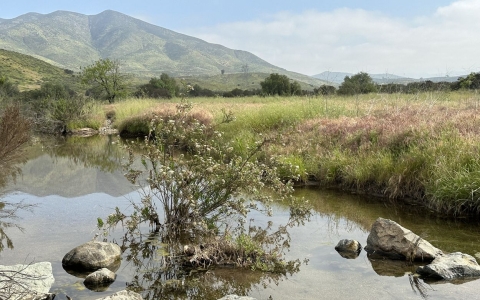The Nature Conservancy (TNC), California Department of Fish and Wildlife (CDFW), California Wildlife Conservation Board (WCB) and United States Fish and Wildlife Service (USFWS) have collaborated to complete the acquisition of approximately 1,291 acres of property in Proctor Valley in southwestern San Diego County, an area adjacent to CDFW’s Rancho Jamul Ecological Reserve and USFWS’s San Diego National Wildlife Refuge. As this property sits at the heart of more than 60,000 protected acres, its acquisition now successfully links and connects the reserve-refuge conservation area conservation area
A conservation area is a type of national wildlife refuge that consists primarily or entirely of conservation easements on private lands. These conservation easements support private landowner efforts to protect important habitat for fish and wildlife and major migration corridors while helping to keep agricultural lands in production.
Learn more about conservation area , saving it from potential development and habitat fragmentation. The property will be owned and managed by CDFW as an expansion of the Rancho Jamul Ecological Reserve.
“Wildlife connectivity is a top priority of the state, and it’s encouraging to see years of work finally come to fruition,” said Charlton H. Bonham, director of CDFW. “Today’s closing shows the greatest value of this property is connecting the San Diego National Wildlife Refuge to the Rancho Jamul Ecological Reserve and the Otay Mountain Wilderness Area. Wildlife that uses this land will now have much more room to roam.”
“It is hard to overstate the importance of this transaction,” said Scott Morrison, director of conservation and science for TNC in California. “Protecting this property fortifies the very cornerstone of southern California’s regional conservation planning efforts. Its protection enhances the resiliency of countless conservation investments made by the public in this region over the decades. What an inspiring testament to the power of partnership and commitment. It’s an achievement of the whole of San Diego’s incredible conservation community.”
Nearly 70% of the property was targeted for development, which would have fragmented the rare and highly biodiverse coastal sage scrub preserve and led to the loss of core habitat for numerous rare and endemic species, like the Quino checkerspot butterfly and the San Diego fairy shrimp, and essential foraging habitat for the coastal California gnatcatcher and golden eagle, if the development had occurred.
"The conservation of this land is a significant step forward for our vision of establishing a set of connected, managed lands across Southern California," said Paul Souza, Pacific Southwest regional director of the USFWS. “This achievement was made possible through our strong, enduring partnerships with federal, state and local organizations, and we want to recognize their hard work to get this acquisition across the finish line.”
TNC, CDFW, WCB, USFWS and numerous other public and private conservation partners have prioritized for protection properties needed to establish a network of core area reserves and habitat linkages essential to preserving biodiversity and enhancing resiliency in the face of global climate change climate change
Climate change includes both global warming driven by human-induced emissions of greenhouse gases and the resulting large-scale shifts in weather patterns. Though there have been previous periods of climatic change, since the mid-20th century humans have had an unprecedented impact on Earth's climate system and caused change on a global scale.
Learn more about climate change . Much of this conservation is due to the foundational San Diego County Multiple Species Conservation Plan (MSCP), adopted in 1997 by the County of San Diego. This plan was created as one of the earliest state-approved Natural Communities Conservation Plans (NCCP) and the federally approved Habitat Conservation Plan (HCP).
Following negotiations and TNC securing an agreement with the landowner to acquire the property for conservation, WCB approved $30 million for the purchase.
“WCB is proud to carry out this major conservation victory and permanent protection of important biological, scenic and cultural resources for the people of California,” said Jennifer Norris, WCB executive director. “I am thankful for our staff at WCB and our partners at TNC and USFWS for facilitating this complex transaction that provides for permanent protection of rare and endangered species such as the Quino checkerspot butterfly.”
Other funding for the property comes from TNC through private donors, USFWS and the Department of Homeland Security (DHS). The $25 million from DHS came to the State of California for the purchase of the property from a settlement agreement over the construction of the U.S.-Mexico border wall.
“The partnerships and public and private funding brought to this acquisition are notable,” said Mike Sweeney, executive director of the California Chapter of TNC. “The State of California, in particular, WCB and CDFW, and our federal partners at the USFWS have shown up in a significant way through their investment of funds and commitment of staff. TNC celebrates what we have all achieved today.”
The reserve-refuge conservation area, which now includes the Proctor Valley property, has been a focus of significant conservation investment over the last three decades and is one of the most important target areas in California, as it contains numerous endangered and threatened species that depend on substantial conserved private and public landholdings for survival. This purchase bolsters land protection in, and reduces threats to, this landscape and continues to build out the core area preserve and to protect habitat connectivity so animals can move and adapt as they live in and move through the reserve-refuge conservation area.
This news release was originally published by The Nature Conservancy on their website on Jan. 26, 2024.
Media Contacts:
Armin Mahramzadeh, The Nature Conservancy: a.mahramzadeh@tnc.org
Mark Topping, Wildlife Conservation Board: Mark.Topping@wildlife.ca.gov
Jane Hendron, U.S. Fish and Wildlife Service: jane_hendron@fws.gov



